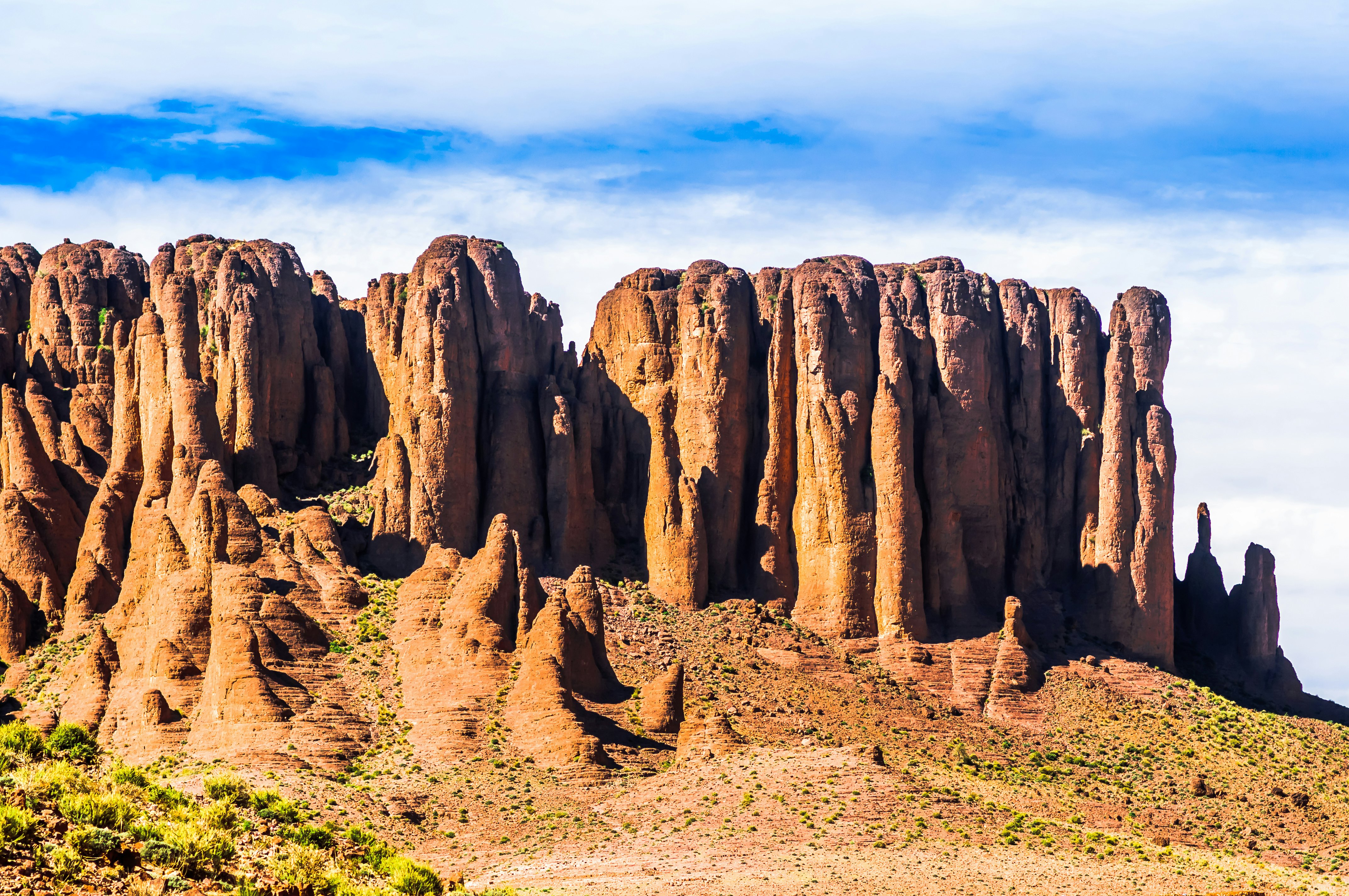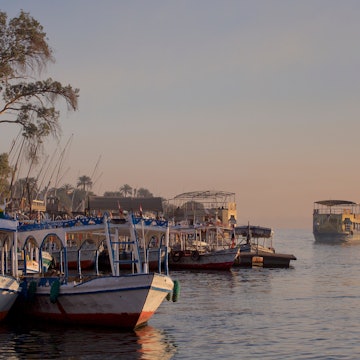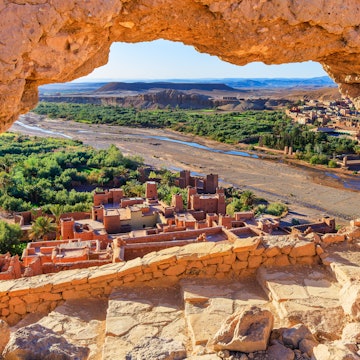

Some of the most rewarding treks in the High Atlas are below the summit of Toubkal, such as the Toubkal Circuit. Alberto Loyo / Shutterstock
Being the highest peak in North Africa, the 4167m summit of Toubkal has become the most popular tourist draw in the High Atlas Mountains of Morocco. Yet the best of the region's hiking trails are actually found beyond Toubkal's crown. So while the crowds are snaking slowly up the two-day ascent of Toubkal, an abundance of incredible other routes across these rugged ridges remain largely unexplored by tourists.
These trails follow centuries-old shepherds' paths between remote villages, allowing you to interact with Amazigh (Berber) villagers and experience their unique hospitality, architecture and language. And along the way you'll cross mountain pastures, skirt below craggy massifs and over panoramic passes. All in all, these routes provide you with a culturally immersive experience and a variety of landscapes that a direct summit shot could never hope to match.
Toubkal Circuit
Starting from the same trailhead as the Toubkal ascent and eventually climbing to the same summit, this circuit eschews the direct summit path to follow a seven-day ring around the Toubkal Massif through a challenging landscape that explores traditional lifestyles of the region.
You'll still need a local guide – this is mandatory for all Toubkal ascents – but the cultural insights they provide make interactions along the trail considerably more rewarding. Loping past the homes of seasonal herders in the summer pastures of Azib Likemt, trekkers may be invited for tea with these locals who live an agricultural and pastoral lifestyle that has been practised in the valley for centuries.
Descending into the village of Amsouzart, through prosperous walnut orchards and past crumbling pisé (rammed earth) houses now abandoned in favour of modern constructions, the curiosity of village children is punctuated by the friendly greetings of shopkeepers – and if you're lucky, one of these will be accompanied with an offer to sample the valley's exquisite local honey.
Read more: How to climb Toubkal, Morocco's highest peak

Above Amsouzert, the diminutive Ifni Lake is an unlikely but popular weekend party destination for Marrakechis escaping the hot summers below; for hikers, however, it's primarily a stop for lunch or a fresh-squeezed orange juice before ascending further towards a campsite just below the Tizi n'Ouanoums pass.
Though not straightforward and even a bit treacherous (you'll be happy to have that guide along), a small side path leads up a back-side ascent of the Toubkal Pass (4000m) to join the final leg towards the summit. It is possible to finish the trek back in Imlil the same day, but hikers with legs left under them often head over the Tizi n'Aguelzim pass to the impressive Cascades d'Irhoulidene and another small pasturage at Azib Tamsoult, before looping back to the trailhead.
Read more: Solo parenting in the foothills of Morocco's Atlas Mountains

M'Goun Traverse
Trails through flowing streams and up rocky ravines, with overnights in remote villages under towering kasbahs (fortresses), characterise the three-day M'Goun Traverse. But it's the the 4071m Jbel M'Goun that dominates this route. Rugged landscapes across the range and a traditional resistance to centralised authority have left the valleys here disconnected – both culturally and geographically – from regions nearer to Marrakesh; the trailhead village of Agouti in Aït Bougoumez was finally reachable by road only in 2016.
Luckily for hikers, many old shepherds' trails that cross the mountains remain, including the long hike above the Aït Bougoumez and several over small passes to the Tifra Valley village of Rougoult. The latter is one of the most beautiful villages anywhere in the M'Goun – its traditional-style houses hold fast to hillsides above the verdant small fields on either side of the Tifra River, all of it overlooked by one of the region's most picturesque kasbahs. Hikers often stay in the handful of informal guesthouses here, though it's equally appealing to fall asleep on a rooftop as the dark line of high peaks divide the twinkling stars above from the village lights below.
Read more: Where to get off the beaten track in Morocco

Atop the 2900m Tizi n'Rougoult, three hours up (or, in springtime, often through) the Tifra River, views stretch to each horizon past ochre rock walls and to tempting trails that lead to Jbel M'Goun and beyond. The path you take leads down to the prosperous village of Amezri, which sits alongside the Tassaout River. Amezri is the largest village in the region (thanks in part to a new mountain road to the market at Skoura), and its relative sprawl rewards aimless wandering with warm welcomes from locals.
The final stretch down the Tassaout Valley leaves hikers with two options: a straightforward road walk through pleasant villages – mostly notably impressive cliffside Ichbaken – or a higher-altitude trail through shepherds' pastures and picturesque passes, ending in Aït Alli n'Ito at one of the best guesthouses in the region: Gîte d'Étape Assanfou, itself a good base for day-hikes to nearby traditional villages like Magdaz and Fakhour.
Read more: Essential Moroccan experiences you won't want to miss

Jbel Saghro
The Saghro Massif presents a completely different face from Morocco's more popular hiking destinations. Harsh desert landscapes and palm-flanked oases replace the higher elevations' lush valleys and scattered villages, but the views here are no less picturesque for it, and the hospitality no less warm.
Expect hiking days to be somewhat longer here than elsewhere in the country – both in distance and duration. The trails peak out at the 2712m Amalou n'Mansour, which means the climbs are considerably shorter and the slopes considerably gentler. Combined with long, lazy lunches to escape the midday heat, a Saghro hike can feel like a laid-back alternative to the more popular regions of the Atlas.
Read more: Why Tangier should be your first port of call in Morocco
The plethora of low-lying, hikeable passes throughout Saghro offer a bewildering array of options for loop hikes or one-way walks between trailhead villages, but most hikers will plan their routes around a handful of cultural and natural highlights. The village of Assaka n'Aït Ouzzine is one that stands out; its centuries-old agadir (traditional granary) stands crumbling back into the sands of a postcard oasis, with palm trees lining the small stream below (reached by small beaten footpaths off the end of village lanes).
At the intersection of three valleys, dirt roads lead west over the Tagmout pass to the twisting rocky canyons below and east over the Tagourt pass to dramatic landscapes with names like 'Camel's Head Hill' and the 'Needles of Saghro'. Onwards, above the Ouarg Valley, the peak of Jebel Kouaouch (2595m) offers views that rival even those from Toubkal. Stretching from the M'Goun Massif far to the north and the dunes of the Sahara in the south, Saghro's most impressive panorama takes in not only the breadth of Morocco's beautiful landscapes but also a countless number of valleys, villages and hikes still waiting to be explored.
















